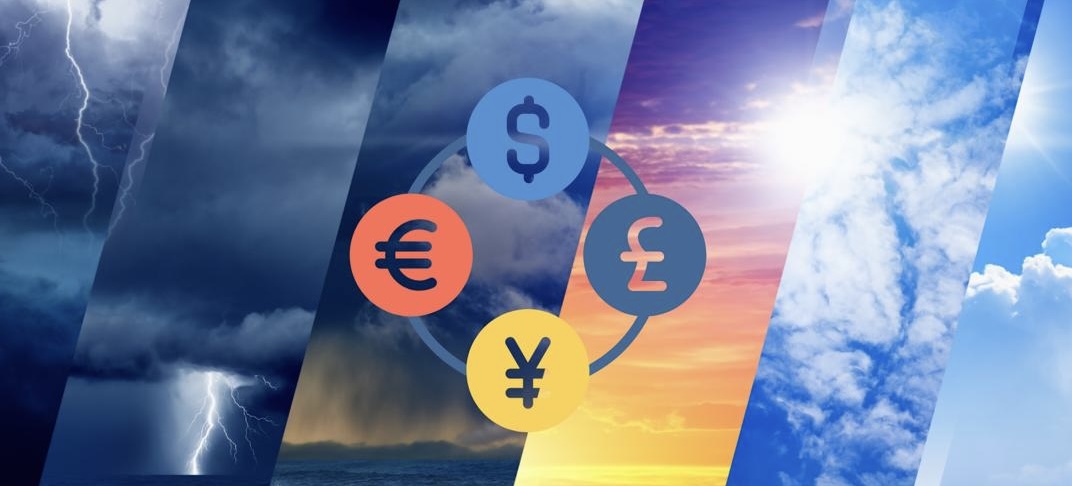Have you ever looked at the weather report before deciding what to take on a trip? That is the same kind of discretion that global corporate have to be aware of with regard to foreign exchange (FX). As is the case with changes in climate, FX markets are influenced by world events, both anticipated as well as unexpected. Elections, wars, interest rate movement, and supply chain crisis are only some examples of events that cause the so-called FX Weather.Economist is not the only one who needs to know this pattern: this is vital to CFOs, exporters and SMEs which have to deal with international payments.
Knowing whether to carry an umbrella or a sunscreen can be the difference between a good and a bad day, similarly, knowing the FX trends will save your bottom line. It is due to such events outside a company and across the globe that causes currency weather, and, in this article, the author has discussed how businesses and SMEs in particular can seek to be prepared against the storm.
What is FX Weather.
The currency world with its geopolitical and economic factors is changing like the weather and thus this world is referred to with the metaphor of FX weather.Just as the weather is subject to seasons, molecular weather (or FX movements), could be just that; seasonal, sudden, or long-term trends, flirting between normal variations all the way to wild volatility.
The weather associated with calm FX are the low which are associated with economic stability, synchronized growth of the globe and stable monetary policy. On the contrary, turbulence FX conditions may be occasioned by crisis, inflation spikes as well as political instability. The above conditions influence cross-border pricing, payment, and planning, which are aspects that SMEs are the most vulnerable, since they have little buffers and resources.
The FX weather reading assists the business to determine when to change the currency to the foreign one, the cost of the product when displayed in the foreign country as well as understanding the level of exposure whether it needs to be hedged or not.

Storm Systems: Geopolitical-Events That Shake the Currency Markets.
The Geopolitical storms usually lead to instant, occasionally very violent action in the currency markets. Fear, Uncertainty and Capital Flight are caused by Armed conflicts, political upheaval and sanctions. When the danger is in the air, investors pour into the so-called safe havens currencies, such as the US dollar (USD), Swiss franc (CHF) or Japanese yen (JPY), and the riskier currencies, which are frequently in the emerging markets, crash.
The invasion of Ukraine by Russia in 2022 caused ruble collapse and the sudden rise in USD, which brought energy prices up and halted European trade.On the same note, Brexit has caused a lasting turmoil to the British pound and this has shaken the confidence of the UK trade prospects.
As the SMEs would import goods or it would operate in an emerging market, such volatility may imply an increase of any cost suddenly or a loss of margin.The ability to ride out such storms comes with having forward contracts or multi currency accounts.
Winds of Anticipation: Interest Rates, Inflation and Monetary Politics.
Storms are sudden though there are FX patterns that are more rhythmic such as a trade wind. The decision to be made by the central banks, the movement in the inflation and the monetary policy have longer periods before being made and made known.
An increase in the interest rates tends to make a currency strong due to the inflow of the foreign capital. It can be decreased by lower/ negative rates.Illustration: In 2023, the U.S Federal Reserve increased the interest rates in order to fight inflation and this was a positive factor that boosted USD across the world. This impacted on the SME exporters as they would receive invoices in local currencies but would buy goods or raw material quoted in USD.
To predict the currency movement, businesses are encouraged to follow calendars of the central bank (Fed, ECB, BoE) as well as the reports on inflation.This information is updated normally, e.g., through such sources as Reuters, Bloomberg, and the KeyFX insights hub.
Organisational Protection: The Less Foreign The Better.
The action should be taken after a currency crisis just as one packs his or her umbrella after the rains have set in. And, it is high time to act in case your business is based on international payments. KeyFx enables you to find your exposure points, consider all possible ways of hedging, prepare an active FX planning that best suits your activities.
Half Time Reflection: Do not Wait Till the Hurricane Kicks In.
As clear skies can never take away the influence of the undercurrents, such as trade balances, tariffs, and shipping rates, at all times they keep reshaping FX conditions. The national economies that practice a considerable amount of export tend to have a stronger currency whereas a constant trade deficit will be able to weaken it in time.
Case: As the nation of China experienced an uprush in export of electronics, the Chinese yuan gained value and there was an increase in the demand of the currency. Conversely, on one hand, in the situations when the UK has been experiencing escalating import prices after Brexit, the sterling has depreciated.Clogged supply chains – such as the Suez Canal breakdown in 2021 or shortage of semiconductors – do affect FX as well by causing inflation and trade stagnation.
To determine their FX exposure, SMEs in the activities of importing or exporting ought to monitor the location of the suppliers where transactions include the sources of currency whether directly or indirectly.
Understanding the FX Forecast: Real World signals to look at.
You cannot do anything with FX weather but you can be prepared about it.These are the working examples of the signals SMEs can watch out on a regular basis:
–National elections (this can affect the sentiment and the capital flow of investors) Announcements by the central banks and alterations in interest rates
-Monthly inflation, employment and GDP publications
-Commodity prices (in particular oil and food)
-Taxes as well as changes in the tariffs or bottlenecks in the supply chain
-The news of the day (wars, sanctions, and health emergency)
Writing a straightforward FX calendar or taking alerting services would enable businesses to know beforehand a way to handle the currency strategies.Market commentary, alerts, and the access to risk specialists by the clients are offered by KeyFX as well.

Business Impact: Why FX Weather is More Important than ever before.
Business can lose thousands of money due to little changes in the currency. To the SMEs, who tend to deal with shorter margin, prices of products affected by FX fluctuation can initiate:
– Payment to the suppliers and contract pricing.
– Invoices and revenue prospective of customers.
– Margin profit and goods sold costs.
– Time of opening an international expansion or investment.
We can cite a case of an SME based in the U.K and importing goods into the U.K. Assuming that the pound loses 5% against the dollar and they spend 20,000 pound every month on paying invoices, then this means that they lose 1,000 pounds a month to the movement of the FX. In a year, it totalises to more than 12,000 pounds which most people do not realize until the end of the year audit.
Following FX weather, companies will be able to delay payments, renegotiate the terms of their suppliers or hedge large exposures to stay profitable.
KeyFX helps you to navigate Currency Season.
If your finances had a weather service, the KeyFX would keep your business on top of things and covered in an FX fulmar. KeyFX provides SMEs with the visibility and support of knowing what is happening in the market at a given moment, and the associative tools to navigate better in financial decisions, as well as hedging and payments mechanism on a world level.
We have multi-currency solutions which minimize the cost outflow, and also streamline operations around the world without using a finance department.And we can assist you create your own FX strategy right now.

